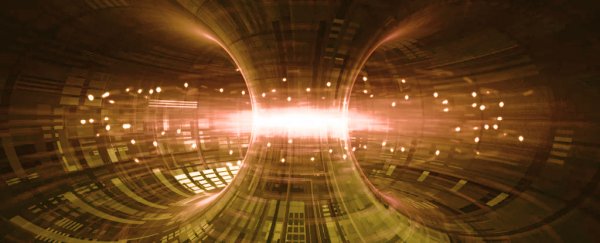China has achieved a new milestone in humanity's experiments to harness the power of the stars.
On Friday, the Chinese Academy of Sciences' fusion machine reached 120 million degrees Celsius (216 million degrees Fahrenheit) and clung onto this for 101 seconds.
The last time EAST (Experimental Advanced Superconducting Tokamak or HT-7U) held onto a writhing loop of plasma for so long was in 2017, but the temperature only reached a mere 50 million °C.
In 2018, the reactor held gas heated beyond the 100 million degree benchmark regarded as crucial for generating power, but could only sustain the plasma for around 10 seconds.
Now that it's held plasma at eight times the temperature of the Sun's core of 15 million °C for such a long period, the new record has nudged the world ever slightly closer to this elusive, yet highly sought-after clean power source.
"The breakthrough is significant progress, and the ultimate goal should be keeping the temperature at a stable level for a long time," Southern University of Science and Technology physicist Li Miao told the Global Times.
Fusion power makes use of the reactions that take place deep inside the Sun, squeezing hydrogen atoms together into larger elements like helium. Where the Sun relies on gravity to force atoms together, here on Earth we have to resort to less subtle means, ramping up temperatures in specially built generators to generate the atom-melding forces.
Researchers estimate that the amount of deuterium - a stable form of hydrogen containing one proton and one neutron - in one liter of seawater could produce the energy equivalent of 300 liters of gasoline through nuclear fusion.
It takes around 300 scientists and engineers to support and operate the experimental facility that contains EAST. This large, donut-shaped metal tube has a series of magnetic coils used to hold superheated streams of hydrogen plasma zooming around the core.
The challenge is to hold the plasma in place for long enough, in a hot-enough inferno, for fusion to occur. It needs to be even hotter than the Sun because our star's much stronger gravity helps squeeze the nuclei together - something we can't replicate here on Earth.
With the theoretical potential to safely produce such vast amounts of energy without greenhouse gases and barely any radioactive waste, fusion power is considered by some as the holy grail of clean energy.
However, at the moment nuclear fusion is not yet a certainty, with a fully functioning 'artificial sun' still likely decades away. We have yet to even reach the point where a fusion reactor can spit out more energy than it consumes, but some experts think we're getting close.
Korea held the previous record of 100 million °C for 20 seconds. Now, China's artificial sun also managed to reach 160 million degrees °C (288 million °F) for 20 seconds, but there's still a long way to go to get the plasma stable at the required high temperatures.
Nuclear fusion is a great pursuit for a future post-carbon society, but meanwhile, we must do all we can to shift to proven clean power technologies to ensure we can even reach such a future.
We can't afford to sit back and wait for such an alluring, technological quick-fix, but every step forward for nuclear fusion certainly is cause for excitement.
